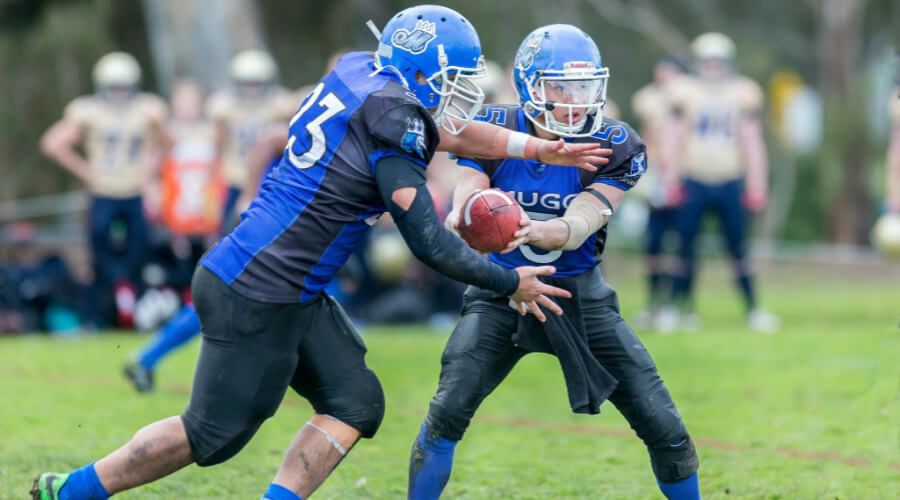Last Updated on October 9, 2023 by Alex PT
The flying wedge is illegal in American football because it is extremely dangerous. In a flying wedge, players would lock themselves together with the ball carrier using their hands and arms and rush forward. This made it very difficult to tackle the ball carrier, but it also led to a high number of serious injuries and fatalities.
- Fact: The flying wedge was outlawed in American football in 1894.
- Number: Over 20 players were killed playing American football in 1893, and the flying wedge was blamed for many of these deaths.
Why Is The Wedge Illegal In Football?

The “wedge” formation, often referred to as the “flying wedge,” is illegal in football for player safety reasons. Here are detailed explanations:
- Injury Risk: The wedge formation involves multiple players linking arms or shoulders and charging forward simultaneously, forming a tight wedge shape. This formation was used primarily on kickoff returns. The problem was that it exposed players to a significant risk of injury, especially head and neck injuries, as they collided with opponents at high speeds.
- High-Impact Collisions: When several players converge into a wedge and collide with defenders, the force generated can be immense. This can lead to concussions, spinal injuries, and other serious health issues for both the attacking and defending players.
- Safety Concerns: The safety of players is a top priority in football. The wedge formation posed an unacceptably high risk of injury, prompting football governing bodies to take action to protect the well-being of athletes.
- Rule Changes: To address the issue, football organizations, including the NFL and NCAA, implemented rule changes that made the wedge formation illegal. These rule changes aimed to discourage and penalize players for forming or using a wedge on kickoff returns.
- Player Welfare: Beyond the rule changes, football has continually emphasized player safety through improved equipment, concussion protocols, tackling techniques, and stricter enforcement of rules designed to minimize dangerous plays.
History Of The Flying Wedge In American Football
Although the exact origin of the flying wedge maneuver is uncertain, its traceable roots can be found in ancient Greece. Historians and scholars of warfare realize that Alexander the Great and other war chiefs often used this military tactic to win their battles. The flying wedge was appreciated by more armies around the world, leading it to evolve into a more enhanced version with time.
In the field of rugby, the flying wedge is a brutal but nonetheless effective technique. The technique was famously employed during a Harvard-Yale football game in 1892. It involves players running forward tightly grouped together with the aim of breaking through opposing defense lines and gaining ground ahead. While it was considered very effective at first, it was later banned across America and the United Kingdom due to its inherently aggressive nature.
Death And The Fall Of The Flying Wedge

While the play was incredibly popular, a dark cloud soon began to develop. Quite simply, the play was too effective. The massive amount of weight and momentum it brought to bear caused tremendous injuries and even deaths. Issues began to develop even though the technique was quite effective and exceptionally famous. While it achieved huge success with some teams, it also led to many injuries and even death among the players during matches and practices.
It’s not uncommon for an innovation to become the very thing it was designed to replace. Harvard coach Lorin F. Deland’s forward pass became a dominant force that changed the game of American football entirely. It opened up spaces on the field that previously had been too risky for players to venture into, thereby revolutionizing tactics and strategy in the process.
As innovative as such changes may seem, there’s always risk involved; in this case, it took just one season for radical rule changes to follow. After several high-profile paralyzing injuries and countless deaths due to collisions with opposing players – forward passes were ultimately banned from college football during the 1896 season! Presidents began calling for a ban on the entire sport until university administrators worked out safer alternatives.
What Was President Theodore V. “Teddy” Roosevelt impact?
In response to the public outcry due to the carnage, President Theodore V. “Teddy” Roosevelt called a summit of influential people in football. A big football fan and an avid player himself, Teddy was determined to save the game and its tattered reputation. His involvement made this meeting of sportswriters and coaches definitive for the sport. A new rule disallowed all forms of the now-banned Flying Wedge formation as well as any other variations found in practice. The end result was that football teams could no longer converge upon a point like a flying wedge or make any quick lateral line movements on purpose before quickly moving forward in the play.
Last Gasp Of The Forward Pass
Kicking play is the type of wedge formation that used to exist in American football. Today, it usually takes place when an offensive player catches the ball. Three or four blockers from behind them in a tight wedge and then run down the field, clearing a path for the ball carrier.
In 2009, the NFL got rid of the dangerous kickoff play called the wedge busters. Basically, it was a subset of the flying wedge in which blockers formed mass around a ball carrier that became so strong and intimidating that teams would be forced to fall back or risk having players injured. While Deland’s handling of his original flying wedge tactic was officially banned in 1986, this attack by kicking off with a squad of men running side-by-side across the field while attempting to slam into foes was finally outlawed only within the last decade.
Conclusion
The Flying Wedge had a great influence on modern football. It was first used in by Harvard’s football team in 1892, and it has made an enormous impact on the popularity of the sport ever since. The formation is so important because of how its success has resulted in rule changes about the legality of such formations along with some limitations to what kind of tactics teams are allowed to use.
References:
https://en.wikipedia.org/wiki/Flying_wedge
https://www.quora.com/Why-is-the-flying-wedge-illegal-in-American-football

Hi! I’m Alex PT. I hold a Bachelor’s degree in Sports Management from Indiana University and have over seven years of valuable experience working in a Sports Event Management Company. I founded SportBlurb with the passion for bringing you the latest, most insightful, and engaging content in the world of sports. So, whether you’re a die-hard fan or want to stay informed, I’ve got you covered!

